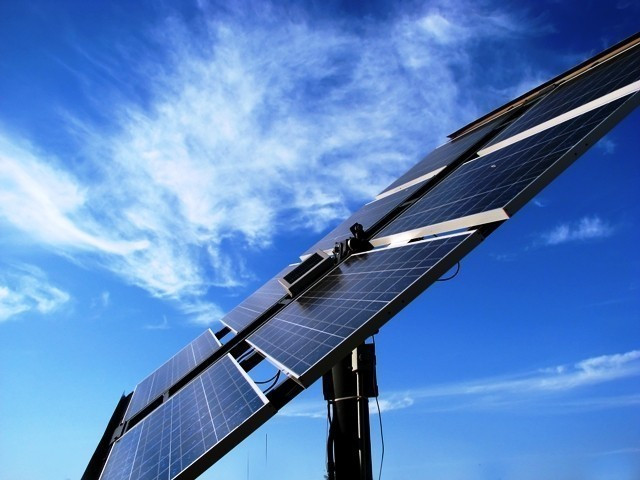Although blessed, Pakistan’s politics remain an obstacle
Most significant challenge has been the government’s political will

PHOTO: REUTERS
Yet, Pakistan’s Alternate Energy Development Board (AEDB) hopes for this under 3% share of wind and solar to ascend to 15% by 2020. Wind and solar, if judiciously priced by National Electric Power Regulatory Authority (Nepra), will be the cheapest forms of power supply with no burden on the environment and at marginal maintenance cost.
Pakistan producing more than 1,000MW of clean energy
The AEDB projection has to be weighed against the scientifically assessed potential, investment climate, bureaucratic reforms and political will of the government.
The last policy for development of renewable energy for power generation floated in 2006 has largely been marred with politicisation of projects and bureaucratic incompetence. The priority to renewable was so negligible that both successive governments did not articulate their vision and strategy over the past decade.
Energy projects
To recap developments so far, the current status of the renewable power generation projects remains at six operational wind power projects of 308.2 megawatts (MW) cumulative capacity are providing electricity to the grid while nine others of 479 MW are under construction.
Additionally, a solar project of 100 MW is operational while three of 100 MW capacity each are under construction.
Furthermore more than 1,300 MW capacity wind and solar projects are at various stages of completion after necessary approvals.
Learning from its blunder of mindless conversion from petrol to natural gas, Islamabad is sticking to its decision of banning new furnace oil-based power generation plants for its existing fuel import bill soars upto $10 billion annual fuel imports.
Contrary to estimate global energy demand growth of 0.7% a year till 2050, Pakistan may need anywhere between 10 to 15% more energy if the growth predictions of today are matched. Nevertheless, fossil fuels will lead the energy market till 2050, 77% of new capacity will be from wind and solar, 13% from natural gas besides other means such as hydro, gas and diesel, says a McKinsey forecast.
'Solar energy need of the hour to counter energy crisis’
The dominant share of hydrocarbon-based power generation was largely due to heavy investments made over the past decades. Such plants would be phased out after completion of their life and generation of projected profits.
Scientific studies confirm that the country has enormous capacity to produce wind energy in unlikely geographical regions, mostly barren, remote and sparsely populated.
For instance, Nokkundi in Chagai district of Balochistan is a rare wind corridor where gales constantly pace up 12.5% higher than requisite for windmills. Lasbella is another district blessed with constant flow of high-speed winds.
Moreover, Dalbandin-Taftan and Gharo-Keti Bandar corridors in Sindh province have an estimated power generation potential of 50,000 MW.
Wind and solar energy
Wind power can alone bring about economic boom not only in coastal and central regions of Balochistan and southern Sindh, especially Karachi and Hyderabad, but also southern Punjab. Combination of solar and wind energy can surpass financial benefits of cotton production boom of yesteryears.
Pakistan happens to be the sixth most privileged country when it comes to solar irradiance with sun shining for more than eight over much of the country’s particularly Sindh, Balochistan, and central and southern Punjab.
Blessed with solar intensity in the range of 1,800 to 2,200 Kwh per square meter daily, the country can not only meet household needs of its populace but also become a production hub for the Middle East.
The existing data suggests that deserts of Thar, Sindh and Balochistan have the capacity to generate more than 250 gigawatts of electric power. To contextualise the projection, Pakistan’s existing installed capacity is less than its one per cent.
For more accurate solar data collection, seven solar data measuring stations were installed in 2014 at nine locations across the country. Currently, data analysis is underway of high quality measurements of the global horizontal, direct normal irradiance, and diffuse radiation.
Though wind farms and solar panels have increasingly become more affordable, the market has been and will continue be unable to meet their demand. The state-of-the-art European equipment comes with a delay of a year to 18 months. Pakistan may have to rely on Chinese industry for its short and medium term needs.
Solar energy: Consumers generate 1.66 MW for IESCO
Fortunately, quartz that is the basic raw material for solar panels is found abundance in northern Pakistan. So is Silica available in the Indus River in endless quantities.
The most significant challenge in addressing Pakistan’s energy security has been the government’s political will and bureaucracy’s capacity to materialise policy guidelines into reality. The country’s energy woes have become increasingly politicised, leaving bureaucrats and investors for actionable advice and common citizen depressed and disillusioned.
Institutions like AEDB can create small but symbolic wind and solar energy project in every city, showcasing the significance of technology.
The writer is an investigative journalist and academic with extensive reporting experience in the Middle East and North Africa
Published in The Express Tribune, November 28th, 2016.
Like Business on Facebook, follow @TribuneBiz on Twitter to stay informed and join in the conversation.



















COMMENTS
Comments are moderated and generally will be posted if they are on-topic and not abusive.
For more information, please see our Comments FAQ